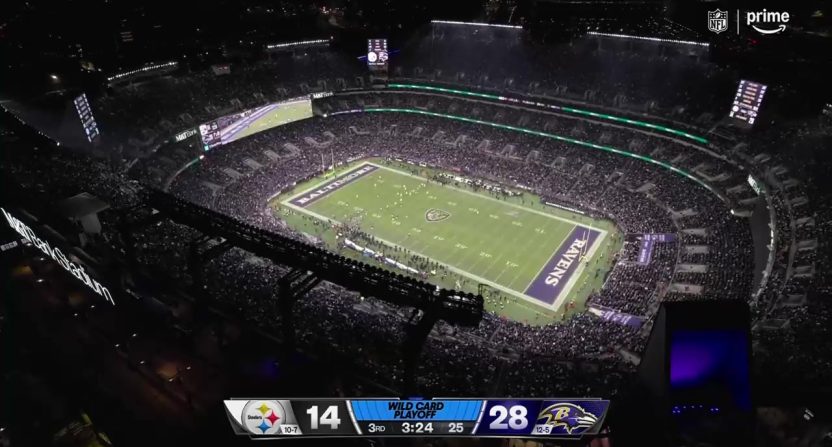Can Mega Events Stay Safe from Drones?
The Role of Cyber Over RF in Crowd Protection
On August 30, the stage in Chiclayo, Peru, was alive with energy. The band was playing, the backing singers were in perfect harmony, and Susana Alvarado was rocking the crowd until, out of nowhere, a drone struck the singer in the face. It hit her forehead and became tangled in her hair. Miraculously, she was unharmed and kept performing. The show went on, but what if it hadn’t?

The Chiclayo incident was not unique. Two weeks earlier in Istanbul, a Limp Bizkit concert showed again how easily a single drone can disrupt a live event. The band was in full flow, the crowd energized, until an unauthorized drone hovered above the stage and audience. It didn’t collide or crash, but the sight alone was enough to unsettle fans and security alike. The show resumed, but it raised questions: how secure are the skies above mass gatherings?
Earlier that year, the NFL Wild Card game between the Ravens and Steelers in Baltimore was interrupted when a drone entered the stadium airspace. Play was suspended until it cleared, leaving tens of thousands of fans waiting in silence and millions watching the disruption unfold live on television.

Prime Video
Whether caused by reckless flying or deliberate misuse, a single drone can throw a mass gathering into chaos. Such incidents are not isolated: mass events like concerts and festivals, sporting events, political rallies, and urban parades attract global attention, but that same visibility makes them vulnerable to incursions that threaten public safety, operational continuity, and even lives.
The Challenges of Protecting Mass Events
For organizers, stakeholders, law enforcement, and security forces, protecting mass events from drones is not a single problem but a layered challenge. These events typically unfold in dense urban environments, where tall buildings, reflective surfaces, and heavy noise make detection of the drone difficult. Small drones flying at low altitudes can blend into skylines or be mistaken for harmless objects.
Detection alone is not enough. Security teams also require reliable identification to distinguish between unauthorized drones and those operated by law enforcement, media, or emergency services. Misidentification can mean overlooking a genuine threat or interfering with authorized operations.
Once a drone is identified, mitigation becomes the next obstacle. In a packed environment, neutralization must be precise and safe. Security teams cannot risk falling fragments injuring spectators, nor can they disrupt GPS, mobile networks, or broadcast systems critical to the event.
Legal limitations make things even more complicated. In many countries, only national-level agencies are authorized to take down drones. Local police or event organizers may spot an immediate threat but lack the legal mandate power to act. Regulations haven’t kept up with the rapid spread of drones, leaving a gap between what’s possible technologically and what’s allowed by law.
Finally, there are the practical realities of cost and usability. Counter-drone systems are often expensive to acquire and maintain, forcing organizers to weigh investment against many other safety requirements. And even when available, many systems are complex, requiring specialist training that temporary or overstretched security teams cannot realistically absorb. A solution that is not affordable, intuitive, and quick to deploy risks being ineffective when it matters most.
Existing Counter-Drone Methods and Their Limitations
To meet these challenges, a range of counter-UAS (C-UAS) methods exists. Each offers strengths, but when applied to mass events, their shortcomings align directly with the issues stakeholders face.
- Radar and Electro-Optical Systems
Reliable in open environments, but in urban venues they struggle with clutter, producing false positives and missed detections. - Acoustic Detection
Useful in controlled settings, but overwhelmed by the loud noises of concerts, stadiums, or city traffic. - Radio Frequency (RF) Scanning
Effective at detecting drone communication links, but heavily dependent on signature libraries (databases of known drone profiles tied to specific makes, models, and protocols). Modified, encrypted, or Do-It-Yourself (DIY) drones often slip through. - Jamming and Spoofing
Widely used for mitigation, but both carry unacceptable risks at mass events. Jamming disrupts GPS, Wi-Fi, or mobile networks relied on by organizers and first responders; spoofing can redirect drones unpredictably, sometimes toward the very crowds being protected. - Kinetic Solutions
Nets, interceptors, or directed-energy systems may be effective in military operations, yet in crowded venues the risk of injuries or unintended damage outweighs their benefits.
Taken together, these methods, while effective in other environments, fall short of what mass events demand: a counter-drone approach that is safe in civilian settings, effective in cluttered urban environments, compliant with regulations, affordable for organizers, and simple enough for non-specialist teams to operate. The gap between what exists and what is needed is exactly where next-generation solutions must deliver.
Cyber Over RF: A Smarter Layer of Counter-drone Protection
The limitations of traditional counter-drone methods leave a clear gap: mass events require protection that is precise, safe, compliant, and reliable in complex urban environments. Cyber over RF (CoRF) fills that gap. Sometimes referred to as cyber takeover, CoRF takes a different path, engaging directly with the communication links between a drone and its operator.
This approach enables instant identification down to the very specific serial number of the device, accurate tracking and pilot localization, and where authorized, it allows defenders to take full control of an unauthorized drone. Instead of causing interference or destructive outcomes, CoRF safely redirects the device, guiding it to a controlled landing, while leaving surrounding communications and authorized drones unaffected.
Unique Advantages of Cyber Over RF
Safety Without Collateral Damage – Unlike jammers or kinetic systems, CoRF acts only on the communication signal between an unauthorized drone and its controller. It does not interfere with Wi-Fi, GPS, mobile networks, or other airspace users. This precision eliminates the risk of unintended disruption, a critical requirement in stadiums, airports, or densely populated city centers.
Takeover Instead of Disruption – Traditional countermeasures typically jam or spoof drone signals, leaving the drone either disabled or behaving unpredictably. Cyber over RF (CoRF), by contrast, enables full, secure takeover of the drone, allowing security teams to safely land or redirect it with precision and control.
Continuity of Operations – Because CoRF operates at the protocol level, it isolates only the rogue drone. Authorized drones, whether broadcasting an event, supporting emergency services, or performing other tasks, continue to operate without interruption.
Compliance with Civilian Standards – Designed as a non-interference solution, CoRF aligns with regulatory frameworks that restrict broad-spectrum jamming or destructive countermeasures. This makes it suitable for lawful deployment in civilian and urban environments, where compliance is as important as effectiveness.
Why Sentrycs Holds the Edge
As a pioneer in Cyber Over RF, Sentrycs has demonstrated how this technology can safeguard even the most challenging mass events. Deployed at scale across multiple environments, including high-profile gatherings, Sentrycs has not only introduced CoRF but also advanced it with critical operational features, from rapid setup to AI-driven detection and seamless integration, making it a practical and proven choice for real-world event protection.
Sentrycs CoRF counter-UAS solution for mass events ensures:
- No collateral damage or communication disruption.
- Autonomous operations
- Does not require line of sight
- Enhanced detection capabilities with Sentrycs Horizon
- Regulatory compliance
- Friend vs. Foe differentiation
- Rapid deployment and scalability
- Each integration with C2 platforms and other security systems
The events detailed earlier in this blog, alongside many other incidents that disrupted mass gatherings over the past year underscore how exposed mass events remain to drone threats. Traditional counter-drone methods have value, but in crowded civilian environments they struggle to deliver the safety, precision, and compliance that stakeholders require.
Sentrycs’ Cyber Over RF solution fills this gap with precise detection, reliable classification, and safe takeover; all without collateral damage or communication disruption. Proven in many real-world deployments, it enables security forces and organizers to protect stadiums and crowds while keeping events running safely and without interruption.
To explore Cyber Over RF in greater depth, download our white paper CoRF — The Ultimate Guide or read our blog post Cyber Over RF — The Future of Counter-Drone Technology Is Already Here.